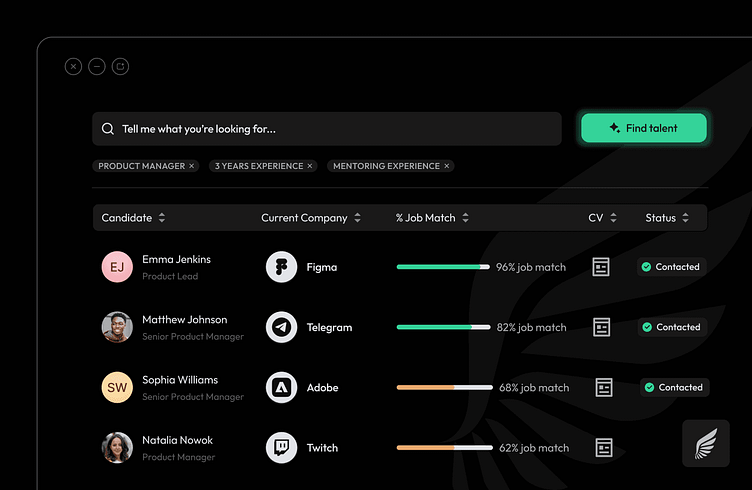UI/UX Concept Designs for AI Hiring Platform
Software used: Figma
As the lead designer, I spearheaded the end-to-end design process for Employers AI’s innovative hiring platform, an AI-driven tool aimed at transforming how hiring managers source, evaluate, and engage with candidates across various industries. The platform is designed to help hiring managers review hundreds of CVs in minutes, auto-generate compelling job advertisements, and reduce unconscious bias in the hiring process — all with the goal of finding ideal candidates faster and more effectively.
Key Contributions:
End-to-End Product Design: I led the entire design process, from initial wireframes and concept designs to the final product ready for development. Although the designs shown here are concept designs, they form the foundation of the complete designs, but these cannot be shown at this stage. These designs focused on delivering a seamless and intuitive user experience, translating complex hiring workflows into easy-to-navigate interfaces that empower hiring managers to make quicker, more informed decisions.
Iterative Branding & Visual Identity Development: Over several rounds of branding and design, we refined the platform’s look and feel until we were happy with the result: a classic and professional aesthetic with a modern edge. The brand identity was crafted to reflect trust, reliability, and innovation, aligning with the platform’s cutting-edge AI capabilities. From colour palettes and typography to UI components, we ensured a cohesive and visually appealing user experience across the board.
Utilisation of Design Systems: I utilised existing design systems as a foundation for the initial designs, ensuring consistency, efficiency, and scalability across the platform. Additionally, I developed Employers AI’s own design system to guide future design work and ensure a unified approach to new features and updates. This custom design system provides a flexible, scalable framework for future iterations, while maintaining a consistent visual language and user experience.
User-Centric Design & Collaboration: Working closely with a senior recruiter who brought deep industry expertise, I took a user-centred approach to the platform’s design. Regular feedback loops allowed us to iterate on the wireframes and prototypes, ensuring the product met the needs of both users and business stakeholders. This iterative process helped refine key functionalities, ensuring that the platform was not only powerful but also intuitive for hiring managers who may not have a technical background.
Cross-Functional Teamwork: I collaborated with the CTO, head of product, and development team to align the design vision with technical and product requirements. Our frequent discussions ensured that the designs were not only aesthetically pleasing but also technically feasible. This close collaboration across departments allowed us to anticipate potential development challenges early on and maintain a smooth design-to-development handoff.
Building for Scale: As the platform is still pre-launch, they are now focused on scaling and preparing for future growth. The design work I led has laid the groundwork for version 2.0 of the product, with designs and systems ready to support additional features and integrations. The goal is to secure funding and bring the platform to market, where it can revolutionise how organisations hire talent.
Outcomes and Impact:
While the platform is still in its pre-launch phase, the iterative design process, coupled with the development of a flexible design system, has established a solid foundation for future growth. The concept designs presented here are a representation of the platform's final direction, with further development happening behind the scenes. Once launched, the platform is expected to offer hiring managers a seamless, AI-powered solution that saves time, reduces bias, and enhances the recruitment process. I look forward to seeing its impact once it's live.


